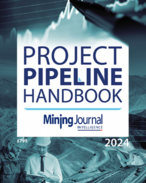This article is 13 years old. Images might not display.
In its mid-year report on mining M&A deals titled Riders on the Storm, PwC expects heightened volatility in global equity markets will filter down into the M&A mining space for the rest of the year.
“From here on in 2011 will undoubtedly be challenging,” PwC global mining leader Tim Goldsmith said.
“We don’t expect global mining M&A in the second half of 2011 to mirror the first, at all. For the time being commodity markets are hostage to politics, a cause for market volatility that, in turn, may lead to withering confidence in M&A markets.”
According to the report, there are signs pointing to a slowdown in activity with deal values and volumes down by 32% and 19% month-on-month in July and a further 25% and 7% respectively in August.
Since June global mining deal values have dipped by 49% and deal volumes have declined by 25%.
The report also highlights that Chinese buyers stayed close to home with 68% of acquisition targets located in emerging markets in the Asia Pacific region.
During the first half, Chinese entities reported 75 acquisitions worth $4.7 billion, an 18% dip on the previous year.
China to save the day?
Goldsmith was quick to point out that while a slowdown is on the cards, China is well positioned to lead a rebound in global mining M&A deals.
“Although a drop off in deal-making is expected, it will not cease altogether as China’s demand for metals, supported by other emerging nations, continues to drive long-term fundamentals and is the most critical factor in formulating the commodity market and, therefore, mining M&A expectations,” he said.
PwC anticipates China will continue acquiring gold and other precious metals as well as iron ore, coal and base metal assets with a focus on frontier markets including Mongolia and Africa.
During the half year two major Chinese deals fell over including China’s Minmetals Resources $7 per share bid for Equinox Minerals, which was scuttled by a higher bid from Barrick Gold, and Yanzhou Coal’s deal for Whitehaven Coal after Whitehaven decided not to go ahead with the sale.
“China walking away from two potentially iconic transactions due to valuation concerns was rather symbolic and further dispels the notion that Chinese entities operate in favour of securing supply at any price,” Goldsmith said.
“We witnessed many instances of Chinese entities managing for profit, not supply, through 2011.
“Going forward, we expect that political and economic forces within the country will incite continued discipline in buy-side M&A activity – Chinese buyers have been quietly amassing minority positions in many companies and they are now going to start exercising their influence, especially if there is an opportunistic downturn.”
During the first half of 2011, 1379 M&A deals were made in the mining sector worth $US71 billion.
There were 11 deals in the $1 billion-plus category which was on par with the previous corresponding period, according to the report.
However, deals were generally smaller with the top 10 global mining deals during the first half of 2011 worth, in aggregate, around $9.2 billion less than the top 10 deals of 2010.
Australian M&A deals were lower than previous years with the country standing at 4% market share by value in announced acquisitions and coming in behind the United States (31%) and Canada (19%).
Coal and iron ore dominated the deal-making activity during the six month period, making up more than 30% of the activity.
According to the report, coal surpassed gold as the most targeted resource by aggregate deal value.























